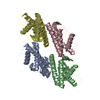+ Open data
Open data
- Basic information
Basic information
| Entry | Database: PDB / ID: 6r21 | ||||||||||||||||||||||||
|---|---|---|---|---|---|---|---|---|---|---|---|---|---|---|---|---|---|---|---|---|---|---|---|---|---|
| Title | Cryo-EM structure of T7 bacteriophage fiberless tail complex | ||||||||||||||||||||||||
 Components Components |
| ||||||||||||||||||||||||
 Keywords Keywords |  VIRAL PROTEIN / VIRAL PROTEIN /  viral complex / DNA ejection viral complex / DNA ejection | ||||||||||||||||||||||||
| Function / homology |  Function and homology information Function and homology informationvirus tail, tube / viral portal complex / symbiont genome ejection through host cell envelope, short tail mechanism / viral DNA genome packaging Similarity search - Function | ||||||||||||||||||||||||
| Biological species |    Enterobacteria phage T7 (virus) Enterobacteria phage T7 (virus) | ||||||||||||||||||||||||
| Method |  ELECTRON MICROSCOPY / ELECTRON MICROSCOPY /  single particle reconstruction / single particle reconstruction /  cryo EM / Resolution: 3.33 Å cryo EM / Resolution: 3.33 Å | ||||||||||||||||||||||||
 Authors Authors | Cuervo, A. / Fabrega-Ferrer, M. / Machon, C. / Conesa, J.J. / Perez-Ruiz, M. / Coll, M. / Carrascosa, J.L. | ||||||||||||||||||||||||
| Funding support |  Spain, 7items Spain, 7items
| ||||||||||||||||||||||||
 Citation Citation |  Journal: Nat Commun / Year: 2019 Journal: Nat Commun / Year: 2019Title: Structures of T7 bacteriophage portal and tail suggest a viral DNA retention and ejection mechanism. Authors: Ana Cuervo / Montserrat Fàbrega-Ferrer / Cristina Machón / José Javier Conesa / Francisco J Fernández / Rosa Pérez-Luque / Mar Pérez-Ruiz / Joan Pous / M Cristina Vega / José L Carrascosa / Miquel Coll /  Abstract: Double-stranded DNA bacteriophages package their genome at high pressure inside a procapsid through the portal, an oligomeric ring protein located at a unique capsid vertex. Once the DNA has been ...Double-stranded DNA bacteriophages package their genome at high pressure inside a procapsid through the portal, an oligomeric ring protein located at a unique capsid vertex. Once the DNA has been packaged, the tail components assemble on the portal to render the mature infective virion. The tail tightly seals the ejection conduit until infection, when its interaction with the host membrane triggers the opening of the channel and the viral genome is delivered to the host cell. Using high-resolution cryo-electron microscopy and X-ray crystallography, here we describe various structures of the T7 bacteriophage portal and fiber-less tail complex, which suggest a possible mechanism for DNA retention and ejection: a portal closed conformation temporarily retains the genome before the tail is assembled, whereas an open portal is found in the tail. Moreover, a fold including a seven-bladed β-propeller domain is described for the nozzle tail protein. | ||||||||||||||||||||||||
| History |
|
- Structure visualization
Structure visualization
| Movie |
 Movie viewer Movie viewer |
|---|---|
| Structure viewer | Molecule:  Molmil Molmil Jmol/JSmol Jmol/JSmol |
- Downloads & links
Downloads & links
- Download
Download
| PDBx/mmCIF format |  6r21.cif.gz 6r21.cif.gz | 2.2 MB | Display |  PDBx/mmCIF format PDBx/mmCIF format |
|---|---|---|---|---|
| PDB format |  pdb6r21.ent.gz pdb6r21.ent.gz | Display |  PDB format PDB format | |
| PDBx/mmJSON format |  6r21.json.gz 6r21.json.gz | Tree view |  PDBx/mmJSON format PDBx/mmJSON format | |
| Others |  Other downloads Other downloads |
-Validation report
| Arichive directory |  https://data.pdbj.org/pub/pdb/validation_reports/r2/6r21 https://data.pdbj.org/pub/pdb/validation_reports/r2/6r21 ftp://data.pdbj.org/pub/pdb/validation_reports/r2/6r21 ftp://data.pdbj.org/pub/pdb/validation_reports/r2/6r21 | HTTPS FTP |
|---|
-Related structure data
| Related structure data |  4706MC  4667C  4669C 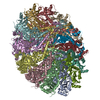 6qwpC 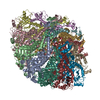 6qx5C  6qxmC C: citing same article ( M: map data used to model this data |
|---|---|
| Similar structure data |
- Links
Links
- Assembly
Assembly
| Deposited unit | 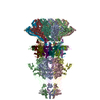
|
|---|---|
| 1 |
|
- Components
Components
| #1: Protein | Mass: 59173.984 Da / Num. of mol.: 12 Source method: isolated from a genetically manipulated source Source: (gene. exp.)    Enterobacteria phage T7 (virus) / Production host: Enterobacteria phage T7 (virus) / Production host:   Escherichia coli (E. coli) / References: UniProt: P03728 Escherichia coli (E. coli) / References: UniProt: P03728#2: Protein | Mass: 26202.820 Da / Num. of mol.: 12 Source method: isolated from a genetically manipulated source Source: (gene. exp.)    Enterobacteria phage T7 (virus) / Gene: 11 / Production host: Enterobacteria phage T7 (virus) / Gene: 11 / Production host:   Escherichia coli (E. coli) / References: UniProt: P03746 Escherichia coli (E. coli) / References: UniProt: P03746#3: Protein | Mass: 89480.594 Da / Num. of mol.: 6 Source method: isolated from a genetically manipulated source Source: (gene. exp.)    Enterobacteria phage T7 (virus) / Gene: 12 / Production host: Enterobacteria phage T7 (virus) / Gene: 12 / Production host:   Escherichia coli (E. coli) / References: UniProt: P03747 Escherichia coli (E. coli) / References: UniProt: P03747 |
|---|
-Experimental details
-Experiment
| Experiment | Method:  ELECTRON MICROSCOPY ELECTRON MICROSCOPY |
|---|---|
| EM experiment | Aggregation state: PARTICLE / 3D reconstruction method:  single particle reconstruction single particle reconstruction |
- Sample preparation
Sample preparation
| Component |
| ||||||||||||||||||||||||||||||
|---|---|---|---|---|---|---|---|---|---|---|---|---|---|---|---|---|---|---|---|---|---|---|---|---|---|---|---|---|---|---|---|
| Molecular weight |
| ||||||||||||||||||||||||||||||
| Source (natural) |
| ||||||||||||||||||||||||||||||
| Source (recombinant) |
| ||||||||||||||||||||||||||||||
| Details of virus | Empty: NO / Enveloped: NO / Isolate: STRAIN / Type: VIRION | ||||||||||||||||||||||||||||||
| Buffer solution | pH: 7.8 / Details: 50 mM Tris-HCl pH 7.8, 100 mM NaCl, 10 mM MgCl2 | ||||||||||||||||||||||||||||||
| Buffer component |
| ||||||||||||||||||||||||||||||
| Specimen | Conc.: 0.8 mg/ml / Embedding applied: NO / Shadowing applied: NO / Staining applied : NO / Vitrification applied : NO / Vitrification applied : YES : YES | ||||||||||||||||||||||||||||||
| Specimen support | Details: acetone and treated with 0.1% w/v poly-L-Lysine (Sigma) for 1 min in water Grid material: COPPER/RHODIUM / Grid mesh size: 300 divisions/in. / Grid type: Quantifoil R2/2 | ||||||||||||||||||||||||||||||
Vitrification | Instrument: FEI VITROBOT MARK IV / Cryogen name: ETHANE / Humidity: 95 % / Chamber temperature: 295.15 K |
- Electron microscopy imaging
Electron microscopy imaging
| Experimental equipment |  Model: Titan Krios / Image courtesy: FEI Company |
|---|---|
| Microscopy | Model: FEI TITAN KRIOS |
| Electron gun | Electron source : :  FIELD EMISSION GUN / Accelerating voltage: 300 kV / Illumination mode: FLOOD BEAM FIELD EMISSION GUN / Accelerating voltage: 300 kV / Illumination mode: FLOOD BEAM |
| Electron lens | Mode: BRIGHT FIELD Bright-field microscopy / Alignment procedure: COMA FREE Bright-field microscopy / Alignment procedure: COMA FREE |
| Specimen holder | Cryogen: NITROGEN / Specimen holder model: FEI TITAN KRIOS AUTOGRID HOLDER |
| Image recording | Electron dose: 0.84 e/Å2 / Detector mode: COUNTING / Film or detector model: GATAN K2 SUMMIT (4k x 4k) |
- Processing
Processing
| Software | Name: PHENIX / Version: (1.12_2829:phenix.real_space_refine) / Classification: refinement | ||||||||||||||||||||||||||||||||||||||||||||||||||||||||||||||||||||||||||||||||||||||||||
|---|---|---|---|---|---|---|---|---|---|---|---|---|---|---|---|---|---|---|---|---|---|---|---|---|---|---|---|---|---|---|---|---|---|---|---|---|---|---|---|---|---|---|---|---|---|---|---|---|---|---|---|---|---|---|---|---|---|---|---|---|---|---|---|---|---|---|---|---|---|---|---|---|---|---|---|---|---|---|---|---|---|---|---|---|---|---|---|---|---|---|---|
| EM software |
| ||||||||||||||||||||||||||||||||||||||||||||||||||||||||||||||||||||||||||||||||||||||||||
CTF correction | Type: PHASE FLIPPING AND AMPLITUDE CORRECTION | ||||||||||||||||||||||||||||||||||||||||||||||||||||||||||||||||||||||||||||||||||||||||||
| Symmetry | Point symmetry : C6 (6 fold cyclic : C6 (6 fold cyclic ) ) | ||||||||||||||||||||||||||||||||||||||||||||||||||||||||||||||||||||||||||||||||||||||||||
3D reconstruction | Resolution: 3.33 Å / Resolution method: FSC 0.143 CUT-OFF / Num. of particles: 92382 / Symmetry type: POINT | ||||||||||||||||||||||||||||||||||||||||||||||||||||||||||||||||||||||||||||||||||||||||||
| Atomic model building |
| ||||||||||||||||||||||||||||||||||||||||||||||||||||||||||||||||||||||||||||||||||||||||||
| Atomic model building |
| ||||||||||||||||||||||||||||||||||||||||||||||||||||||||||||||||||||||||||||||||||||||||||
| Refinement | Highest resolution: 3.33 Å / Cross valid method: THROUGHOUT | ||||||||||||||||||||||||||||||||||||||||||||||||||||||||||||||||||||||||||||||||||||||||||
| Displacement parameters | Biso max: 184.86 Å2 / Biso mean: 90.971 Å2 / Biso min: 49.88 Å2 | ||||||||||||||||||||||||||||||||||||||||||||||||||||||||||||||||||||||||||||||||||||||||||
| Refine LS restraints |
|
 Movie
Movie Controller
Controller




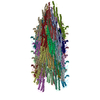


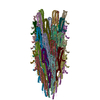
 PDBj
PDBj